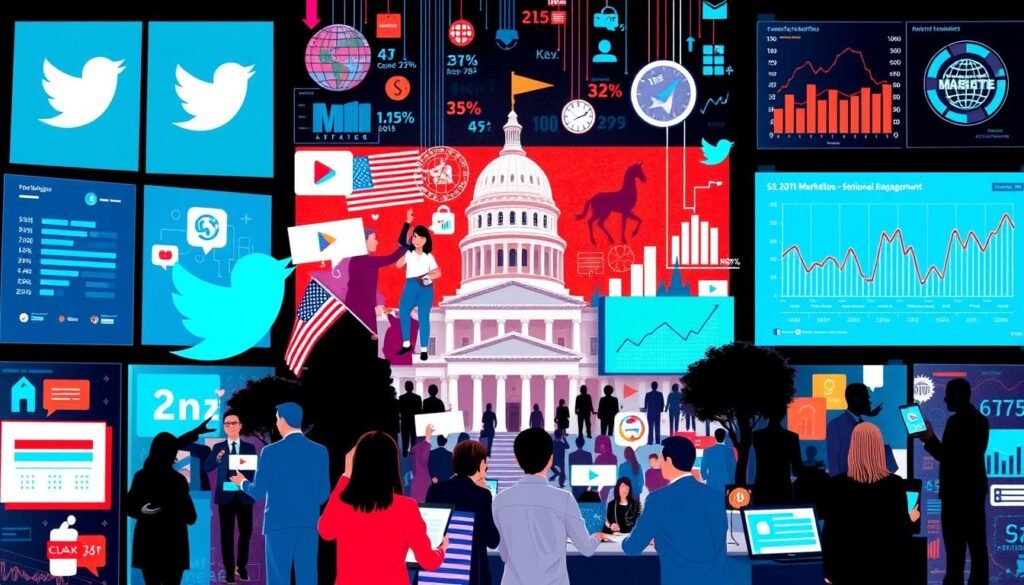How to Get Into Politics Using Digital Marketing and Social Media
Political ads are expected to hit over $12 billion in 2024. This shows how big a role digital marketing and social media play in campaigns. The Kamala Harris campaign is spending $200 million on digital ads. This shows how important being online is in politics.
Political campaigns can get up to 60% more visibility with online ads on Google and Facebook. To win, you need to know how to use digital marketing and social media. This helps candidates become trusted, engage more voters, and reach their goals.
Key Takeaways
- Political advertising expenditure is expected to exceed $12 billion during the 2024 election cycle.
- Digital marketing and social media are key for campaigns, with 80% using them to connect with voters.
- Targeted online ads can boost visibility by up to 60%.
- Knowing how to use digital marketing and social media is vital for success.
- Good online campaigning needs a solid grasp of strategies and digital ad benefits.
- Candidates can boost voter engagement by up to 50% with personalized emails and 25% with videos.
Understanding the Modern Political Landscape
The modern political scene is all about digital platforms in political campaign strategies and online political campaigning. It’s key to grasp the digital shift in political engagement, current trends in political communication, and the digital platforms that matter most.
Recent stats show that US political ad spending could hit over $12 billion in 2024. Digital ad spending is expected to jump by 156% from 2020 levels. This shows how vital it is to invest in digital marketing, not just traditional methods.
Important digital platforms for political influence include social media like X (formerly Twitter), Facebook, and Instagram, plus new ones like TikTok. These sites offer great chances for political campaign strategies and online political campaigning. For example, 59% of X users and 36% of TikTok users follow politics or political issues on these platforms.
To make the most of digital political engagement, campaigns need to use data analytics. This helps them understand voter preferences and craft messages that hit home. It’s all about creating personalized content that voters can relate to.
| Platform | Users Keeping Up with Politics |
|---|---|
| X (formerly Twitter) | 59% |
| TikTok | 36% |
| 26% | |
| 26% |
Building Your Political Brand Identity
Having a strong online presence is key for political campaigns. Political social media marketing helps candidates get noticed, connect with voters, and gain followers. With 3.6 billion people on social media worldwide, the reach is huge.
Using digital political engagement can really boost voter turnout. For example, talking directly to voters on social media can increase voter mobilization by 25%. Also, social media for political activism lets candidates share their personal stories. About 75% of voters are more likely to support a candidate who tells their story well.
Some important stats for building your political brand include:
- 65% of voters say social media shapes their opinions on candidates and issues
- Candidates with a strong online presence can engage with voters 30% more
- Using consistent visual branding can make a candidate 60% more recognizable
By using these strategies, candidates can create a strong political brand. This can help them succeed in today’s digital world.
| Strategy | Effectiveness |
|---|---|
| Targeted advertising | Up to 50% higher conversion rate |
| Emotional storytelling | 40% increase in voter support |
| Consistent visual branding | 60% increase in campaign recognition |
Essential Digital Marketing Tools for Political Success
Effective digital political engagement needs a variety of tools and strategies. Social media for political activism is key, letting politicians reach voters and boost their campaigns. They use political campaign digital strategies like content systems, email platforms, and social media tools.
Some top tools for digital marketing in politics are:
- Content management systems for campaign websites
- Email marketing platforms to connect with voters
- Social media tools for posting content
- Analytics to track campaign success
With these tools, politicians can run strong digital marketing campaigns. They can engage with voters and see how well they’re doing. This helps them make their strategies better and increase their chances of winning.
Crafting Your Political Message for Digital Platforms
Effective online political campaigning needs a deep understanding of voters. Political social media marketing helps reach more people and build a strong online image. Digital political engagement is key, letting politicians connect, share their message, and grow a supporter base.
To make a strong political message, consider these important points:
- Clear and concise language
- Emotional appeal
- Relevant issues and policies
- Authenticity and transparency
By using these elements, politicians can craft a message that connects with voters. This message can help them stand out from their opponents.
Politicians can also use data analytics to understand their audience better. This helps them tailor their messages. Tools like social media and email campaigns are great for this. They help politicians reach more people.
| Platform | Engagement Rate |
|---|---|
| 2.5% | |
| 1.8% | |
| 4.2% |
Knowing each platform’s strengths and weaknesses helps politicians. They can then craft their message and strategy to engage more people and reach their audience.
Social Media Strategy for Political Campaigns
Creating a solid social media plan is key for political campaigns. It helps them grow online, connect with voters, and gain loyal supporters. This means using social media for activism, making good digital campaign plans, and engaging digitally.
Candidates should post on Facebook and LinkedIn 1-2 times a day. On X (formerly Twitter), they should post 2-3 times a day. Instagram posts should be 3-5 times a week, with 2 stories each day. TikTok should have 3-5 videos weekly, and YouTube should have 2-3 shorts and 1 full video weekly.
Platform-Specific Content Strategies
It’s important to keep a consistent brand on all platforms. Young voters, who are big on social media, play a big role in many elections. Using social media for activism helps candidates get seen by more people.
Engagement Tactics and Community Building
Getting people to interact is key, as algorithms can hide posts. Candidates should reply to comments, use hashtags, and make interesting content. This builds a community and boosts the campaign’s online presence.
- Post on Facebook and LinkedIn 1-2 times a day
- Post on X (formerly Twitter) 2-3 times a day
- Post on Instagram 3-5 times per week, along with 2 stories daily
- Create 3-5 TikTok videos weekly
- Feature 2-3 YouTube shorts per week and 1 full video weekly
By following these steps, candidates can make the most of social media. They can use it for activism, make effective digital campaigns, and engage more people online.
How to Get Into Politics Using Digital Marketing and Social Media: A Strategic Framework
To succeed in politics, understanding digital marketing and social media is key. These tools help shape public opinion and sway voters. By using online political campaigning strategies, you can boost your visibility and connect with your audience.
A good political campaign strategy mixes digital marketing tools. This includes social media, email marketing, and content creation. These tools help candidates reach more people, engage voters, and build a strong online image.
Key parts of a winning online political campaign are:
- Building a strong brand identity
- Creating engaging content
- Using social media platforms well
- Having a detailed digital marketing plan
By using this framework and How to Get Into Politics Using Digital Marketing and Social Media, you can boost your political success.
Data-Driven Campaign Optimization
Effective political campaigns use data to reach more people and engage them better. They use digital tools to target specific groups and boost their online presence. This approach helps campaigns connect with voters more effectively.
It’s important to understand analytics and metrics for campaign success. Campaigns analyze voter data to create ads that speak to certain groups. For example, targeted political campaign ads use demographics and interests to save money and boost engagement.
Key Strategies for Data-Driven Campaign Optimization
- A/B testing political messages to evaluate effectiveness and optimize engagement metrics
- Audience segmentation techniques to create personalized messaging strategies
- Predictive modeling to assess the likelihood of voters supporting a candidate or voting
By using these strategies, campaigns can make a bigger impact online. Digital tools help them reach their audience and meet their goals. This way, campaigns can engage voters more effectively.
Building and Managing Your Support Network
Effective political social media marketing is key for building a support network. It helps politicians get noticed, talk to voters, and start strong campaigns. Social media for political activism is now a big part of campaigns. It lets politicians reach their audience and share their message.
Having a strong online presence is vital for a loyal following. This means posting often, talking to followers, and using social media management tools to see how you’re doing. This way, politicians can build a strong support network to help them reach their goals.
- 20% of US adults get their political news mainly from social media.
- 18% of adults use social media to find political and election news.
- 48% of social media users aged 18–29 use it for political news.
By knowing these trends and using social media for political activism, politicians can create a strong support network. This network will help them win their campaigns.
Compliance and Legal Considerations in Digital Political Marketing
Politicians and marketers must follow strict legal rules when campaigning online. They need to stick to federal and state laws, and make sure ads are clear. Breaking these rules can lead to big problems, making it key to know the laws well.
Important areas include keeping data safe, following ad rules, and respecting copyrights. The Americans with Disabilities Act and the UK’s Equality Act also require websites to be accessible. With most marketers worried about legal issues, staying compliant is vital.
Some key rules for digital marketers are:
- Data protection laws
- Advertising laws
- Intellectual property rights
- Accessibility standards for websites and online services
By following these rules, politicians and marketers can run legal campaigns. This helps in effective online campaigning and engaging with voters digitally.
| Regulation | Description |
|---|---|
| Data Protection Laws | Protect personal data and ensure its secure processing |
| Advertising Laws | Regulate online advertising to prevent deceptive practices |
| Accessibility Standards | Ensure websites and online services are accessible to individuals with disabilities |
Measuring Campaign Success and ROI
To check if digital political engagement and social media for political activism work, we need to measure success and ROI. Political campaign digital strategies should be based on data to get the best results. Companies look at ROI to see if their marketing is worth it, with a high ROI showing success.
The simplest way to find ROI is: (Sales Growth – Marketing Cost) / Marketing Cost. For example, if sales went up by $1,000 and marketing cost $100, the ROI is 900%. But, we also need to look at other things like organic sales and past trends.
Other important things to watch include sales leads, social media engagement, click-through rates, and search rankings. To figure out digital marketing ROI, we need to track things like phone calls, leads, sales, and how often customers come back.
Tools like Google Analytics 4 help businesses track important metrics. This lets them make smart choices for their political campaign digital strategies. They can see how different channels help and use reports to learn about web traffic and user actions.
Measuring campaign success and ROI is key to knowing if digital political engagement and social media for political activism are working. By watching key metrics and using data-driven political campaign digital strategies, politicians can improve their campaigns. They can also reach more people and connect better with voters.
| Metric | Formula | Description |
|---|---|---|
| Cost per Lead | Ad spend / number of attributed leads | Calculates the cost of acquiring a lead |
| Lead Close Rate | Conversions / number of leads | Calculates the percentage of leads that result in conversions |
| Cost per Acquisition | Cost of advertising / number of conversions | Calculates the cost of acquiring a customer |
Conclusion: Transforming Digital Influence into Political Impact
In today’s digital world, how to get into politics using digital marketing and social media is key. Political campaign strategies are changing fast. The power of online political campaigning is clear.
Politicians use content management systems, email marketing, and social media tools. They build their brand, share messages, and talk directly to voters. With data and audience insights, they can improve their online work and see its effects better.
Platforms like TikTok, X (formerly Twitter), and Instagram change how we talk politics. They help candidates reach many voters and start grassroots movements. But, there’s a big challenge: stopping fake news and keeping digital influence fair.
As politics keeps changing, those wanting to make a difference must use digital marketing and social media wisely. They need to balance using these tools and keeping democracy strong. This way, they can turn digital influence into real political change and help shape our future.
FAQ
How can digital marketing and social media help in getting into politics?
What are the key digital platforms for political influence?
How can a politician build a strong political brand identity online?
What are the essential digital marketing tools for political success?
How can a politician craft a compelling political message for digital platforms?
What are the key elements of a successful social media strategy for political campaigns?
How can data-driven campaign optimization help in political campaigns?
What are the legal and compliance considerations in digital political marketing?
How can a politician measure the success and ROI of their digital marketing campaigns?
Source Links
- Political personas for political digital marketing | Experian Marketing
- Political Marketing: How to Digitally Market Your Campaign
- Digital Marketing Strategies for Political Campaigns (2024)
- A closer look at modern digital political advertising | illumin
- How Americans Navigate Politics on TikTok, X, Facebook and Instagram
- Council Post: Social Media Political Polarization: Marketing In The Age Of Sound Bites
- Political Social Media Marketing: The Ultimate Guide for Campaign Success
- No title found
- Winning Votes with Brand Power: The Role of Branding in Political Campaigns | Burlington Press
- How to run a successful political campaign in 7 steps – NGP VAN
- Digital Marketing for Politicians by Political Marketing Agency
- Democracy in the Age of AI: New Tools for Political Campaigning
- Improve Your Political Campaign By Using Digital Marketing Techniques That Work
- Political Advertising: A Guide to Campaign Messaging Success
- How Do You Craft an Effective Social Media Strategy for Political Campaigns?
- Using Social Media for Political Campaigns
- Political Marketing Strategies To Win Over Voters in 2024
- Top 10 Steps to Win Any Election: A Marketing Blueprint for City, State, or National Campaigns
- Digital Marketing for Politicians (Do’s and Don’ts)
- 5 Tips for Social Media Marketing During Election Season
- Data-Driven Targeted Ads Are Shaping Modern Political Campaigns
- Microtargeting and Data Analytics: Transforming Political Campaigns
- Political Marketing Agency Services: Driving Campaign Success in a Digital Era
- Government and Social Media Guide: How to Build Your Strategy
- Social media use in politics
- What is social media management? Everything you need to know
- 6 categories of laws on social media and digital content marketing | Smart Insights
- The Impact of Political Advertising on Digital Marketing
- How to Calculate the Return on Investment (ROI) of a Marketing Campaign
- Digital Marketing ROI Guide
- Analyzing the Impact of Social Media Engagement on Political Campaigns
- The Power of Social Media to Influence Political Views and Geopolitical Issues: TikTok, X and Instagram
- Social Media’s Influence on Modern Politics: Shaping the Future of Democracy
























